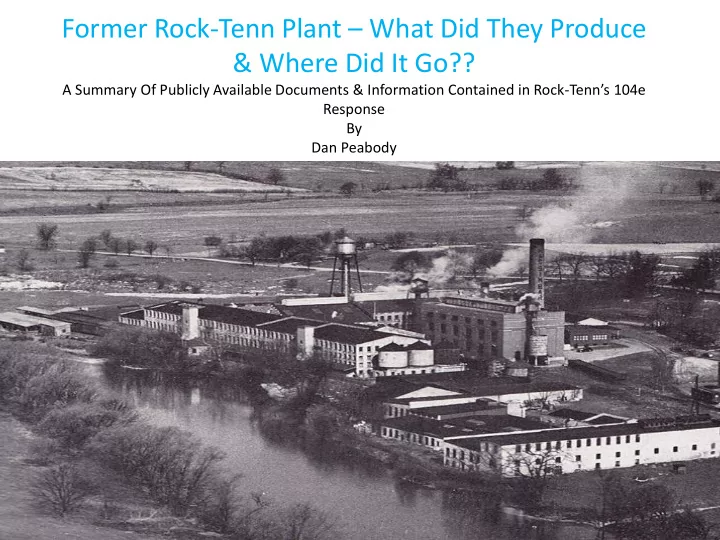

Former Rock-Tenn Plant – What Did They Produce & Where Did It Go?? A Summary Of Publicly Available Documents & Information Contained in Rock- Tenn’s 104e Response By Dan Peabody
Former Rock-Tenn Paper Mill
Former Rock-Tenn Paper Mill – Business History & Facility Operations • • Limited information is available in the Began producing paper in 1906 as documents but the following slides MacSimBar Co. will summarize what was provided. • Acquired by Waldorf Paper Products • Rock-Tenn did not de-ink paper at the in 1960. Otsego facility . • Sold to Mead Paper Co in 1968 • Utilized secondary fiber as raw material in production of multi-ply • Acquired by Rock-Tenn Company in coated and uncoated paperboard and 1987. Shutdown in 2004. some laminate board. – Employed approx. 250 workers. • Produced products such as book blanks, foil- laminated board, and gameboard. – Mostly shipped to Chicago and returns brought materials to be recycled
Former Rock-Tenn Paper Mill – Wastewater Handling – Where Did Wastewater Go? Minor detection of phenols and Metal but all below criteria. • The plan utilized upwards of 2 million gallons – One sample exceed MDEQ GSI/Residential per day in their process and discharge approx. 1 Drinking Water Criteria for PCBs in 1978. million gallons per day to the River • 1979: Aquatic Toxicity – Effluent did not result in significant minnow • mortality. 20-30% of wastewater was pumped into lagoons on the west side of the property • 1988: PCBs, Pesticides, Chlorinated Hydrocarbons – Remaining wastewater was recycled in – Non-detect for all process • 1989: Aquatic Toxicity What Contaminants Were In The Wastewater?? – Effluent was found to be acutely toxic to daphnia • 1971: wastewater effluent samples analyzed for magna (plankton). PCBs. – Cause for toxicity unclear based on analytical – Sample exceeded MDEQ GSI/Residential • Drinking Water Criteria. 1993: Chlorinated Hydrocarbons, Pesticides, PCBs – Non-detect for all • 1974: PCBs, Phthalates, Phenols • 1997: Chlorinated Hydrocarbons, Pesticides, PCBs – Sample non-detect for PCBs and below – Detection of PCBs and phthalates but below criteria for Phenols. Phthalates were criteria detected and provided as Total. • 1976, 1977, 1978, 1979, 1981: samples collected from outfalls and analyzed for water quality param., PCBs select metals (ZN/Cu) and phenols
Former Rock-Tenn Paper Mill – Sludge Handling What is Sludge?? • What Contaminants Were In The Sludge - Also known as Biosolids. Sludge?? Composed of dead bacterial bodies from the aerobic digestion of • 1978- PCBs. Sludge sample dissolved solids as well as other collected and analyzed for PCBs suspended solids such as – 20ppm papermaking fibers, sand, and bark. • 1989: VOCs Where Did The Sludge Go?? – Samples exceeded MDEQ GSI • “Sludge from the clarifiers is recycled back Criteria for 1,1,1- to the mill” Tricholoroethene and MDEQ Res. Drinking Water for • “Settling lagoons captured the effluent, allowed Tetrachloroethene suspended solids to settle out, and then was discharged to the River. The settling lagoons have never been dredged or excavated” • “Dewatered sludge from lagoons is hauled away to a company landfill”
Recommend
More recommend